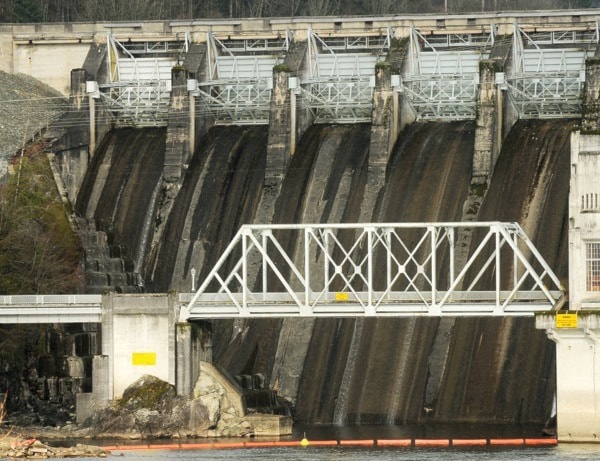B.C. Hydro is about to open its wallet and put $800 million into refitting the aging Ruskin Dam.
So why not increase that by .03 per cent and make a $2.8-million fish ladder on the Alouette reservoir part of the project?
Alouette Lake and Stave Lake are connected by tunnels, allowing the Alouette to feed into Stave Lake.
“Ultimately, it’s a public relations win – before they’re faced with an acrimonious relationship with the public,” as people realize what private power companies in the U.S. are doing to help fish, said Geoff Clayton, with the Alouette River Management Society.
The group is making the proposal in a June 3 letter to B.C. Hydro management.
The society first proposed the project last year after a study by Peter Ward and Associates estimated it would cost $2.8 million to build a fishway beside the spillway and get to the top of the 16-metre dam.
That would allow reconnection of the South Alouette River to the lake, after being severed in the 1920s for construction of the dam. A fishway would allow all five species of salmon, along with trout, to once again reach the lake and to re-enter the streams that flow into it.
ARMS continues to track the sockeye salmon run that it started in 2005 with the release of what was then considered kokanee over the dam spillway and have found that when the sockeye return, they’re using some areas part of the lakeshore for spawning rather than migrating to streams that flow into the lake.
A fish ladder could increase the size of the sockeye run.
Last year, 105 sockeye returned to the base of the dam and were trucked around it and released into the lake. However, some deaths may be connected to handling the fish.
The Alouette group is also afraid that chinook and coho may not be able to survive in the South Alouette over the long term without access to the Alouette reservoir.
The letter says B.C. Hydro will run into opposition when it seeks to renew one of its water licences, which expires in 2018, “without a provision that includes some form of upper watershed access for this historic run of salmon and trout.
“More and more as we look out over the electrical utility industry in North America, we see private utilities awakening to the public demand to address green power projects.”
Clayton points out the Alouette-Stave power generating system is antiquated and also needs upgrading. Improving the generation station at the bottom of the Alouette-Stave tunnels and automating control of the lake level could increase power production by 40 per cent.
But so far B.C. Hydro hasn’t said much about any renovation plans.
“B.C. Hydro has been completely silent as to what their plans are for this Model T generation site,” Clayton said.
“It is old. It is antiquated. It is not automated.”
The letter also includes a link to a video about U.S. utility company, PPL Montana, which recently built a $6-million full-height fish ladder designed to allow bull trout to climb 25 metres over the Thompson Falls hydroelectric dam.
Puget Sound Energy also built fishways on its Mount Baker and Skagit River systems.
In Washington’s Baker River basin, home to PSE’s largest hydroelectric project, fish-restoration efforts have resulted in eight of the 10 highest adult sockeye returns on record, all since the mid-1990s, PSE says on its website.
Clayton says the B.C. government is stifling the Crown corporation because it’s siphoning off too much revenue.
“[Premier] Christy Clark has a chance to do the right thing and tell B.C. Hydro to get green,” Clayton said.
“What we’d like to see is B.C. Hydro step forward.”
He said the society has been studying and researching sockeye salmon in the Alouette system since 2003. “We’re ready to go here.”
Clayton added that if the Site C dam goes ahead, millions of dollars will be spent on reducing the effects of the dam on fish and wildlife.
The Ruskin Dam, which sits on the Maple Ridge-Mission border, was built more than 80 years ago, and hasn’t seen a significant upgrade since the last generator was added in the 1950s.
B.C. Hydro is proposing to replace the dam’s aging powerhouse equipment, while making the dam safe in the event of an earthquake.
When completed, the dam will generate enough electricity to power 33,000 homes and will be able to withstand a one-in-10,000-year earthquake.
B.C. Hydro filed the project application Monday with the B.C. Utilities Commission, which still needs to approve the project before it can move ahead.
But construction could begin as early as 2012.
MLA Marc Dalton supports the fish ladder project.
“Having that fish ladder will definitely replenish the stocks above. I think it’s a great idea.”
He’s going to talk to Energy and Mines Minister Rich Coleman to see if the fishway can be added to the Ruskin renovation project.
On the other hand, the fish ladder could be done later as a separate project.
Perhaps the federal government could be involved, he suggested.
